





Published on Nov 30, 2023
Now day’s electrical energy is not only problem but also serious issue. Because demand of electricity is greater than generation of electricity. In many countries the demand is as large as electricity transmission capacity of that country. These problems are not stopped up to transmission capacity but also increase in prices coal, diesel, petrol etc. Due to burning of these fuels it causes air pollution. As we look towards the renewable energy the generation cost is very high as compared to other generation techniques. By looking towards this problems energy saving is very important factor. This research paper involves the energy management technique. In this project we used the internet though area covered is whole world.
The world's major problem is to generate electrical energy constantly and pollution free. In some countries this problem is very serious that peoples not get electricity to their basic need like TV, fans, house lights. The demand of electricity increasing day by day as shown in “Fig. 1.”
Although government implemented new plants for generation of electricity. But along with generation we have to concentrate on energy management by using today's technology. To manage available electricity some part of villages or cities goes in dark means no single bulb can glow this is. This is nothing but load shedding. From analysis of research paper since from 2005 the Maharashtra’s power sector was fails to provide required electrical energy to the Maharashtra. Several areas in Maharashtra are under 8 to 10 hours under load shedding results in disturb in lifestyle, loss of production. In Maharashtra was persisted for the period of two years or some more time. The demand of electricity through the day is not constant it varies with time. Typically most Indian uses electricity at morning and at evening. As use of electricity at evening is more than at morning because use of residential and commercial lightening. The use of electricity also varies with seasonally.
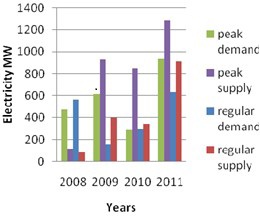
The average unrestricted energy demand for 2005-06 is 10,028 MW whereas the annual average unrestricted energy demand for 2006-07 is 10,438 MW (growth of 4.1 per cent) [3], [4]. Up to 1999-1998, the generation of electricity was sufficient for Maharashtra's peak but now a todays the peak demand exceeding the available capacity. The table 1. Shows the year, peak demand and availability. In this research paper to access modules wirelessly GSM is used. The main agenda to use the GSM shield is that there should not be restriction of distance. Connect the Arduino GSM shield to Arduino possible to access the internet. Just plug this module onto your Arduino board, plug in a SIM card from an operator offering GPRS coverage and follow a few simple instructions to start controlling your world through the internet. It is also possible to make voice call and send as well as receive SMS by using the GSM shield as shown in “Fig. 2.
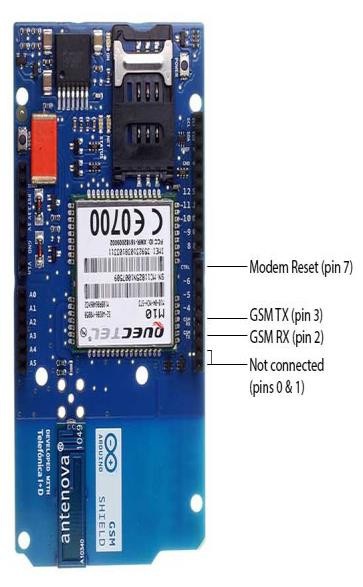
The offset data conditioning card clamp the A.C. with reference to the applied D.C. voltage. The value of reference D.C voltage set according to the maximum load ratings. The circuit diagram of offset current conditioning card is as shown in fig4. The offset data conditioning card consist of two operational amplifier, UA741CN which are operated in inverting mode. The first op-amp is used as summing amplifier. It adds up the input signal with the DC reference voltage.
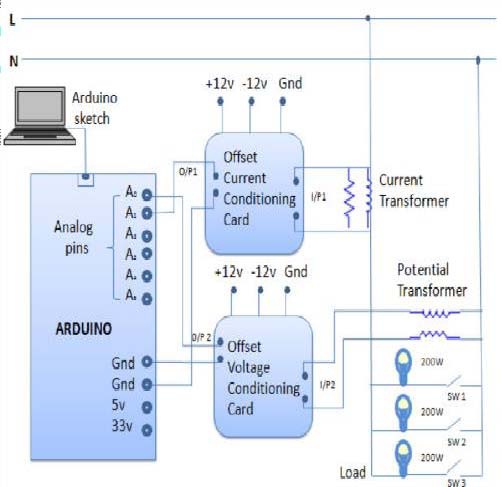
The output of the first op-amp is inverted using the second opamp which acts as an inverting amplifier. The output of this opamp is taken out as the output of the offset data conditioning card [7]. Here the +12V is connected to current offset conditioning card to its proper action. The current offset conditioning card sent energy consumed by consumer to Arduino. By comparing this values Arduino decides to cut off or not the power supply.
Arduino is the microcontroller with USB is connected to computers and it is also possible to external electronic circuit, such as motors, relays, various sensors, diodes, microphones and loudspeakers etc. The Arduino boars as has dual power arrangement, that means it can powered using 5V D.C. battery or supply can provided through USB connected to computer. The Arduino firstly programmed through computer and after disconnection it can work independently. Arduino Duemillanove is used in this project which have ATmega328 microcontroller IC. The software has standard programming language compiler and it also contains boot loader that runs on the Arduino board. The Arduino works on Windows, Linux.
There are also some solutions to stop the load shedding and to stop the load shedding of electricity. As explained in research paper reference [1] the energy management is done by using Zig-Bee. This method has main disadvantage is the distance covered. The Zig-Bee produces its Wireless Personal Area Network (WPAN). Its area is typically 100 meter. Another method is moves the world towards the renewable energy sources. But the as we concern towards the generation cost of generation of electricity from solar energy, wind energy, tidal energy, geothermal energy etc. is very high. To recover the gap between peak demand energy and available energy the government is on the way of implement the new power plant.
As there is large difference between the peak demand and available electrical energy as explained in table 1. But what will happen if available energy is used without load shedding. This research paper introduces a new method that is “Advance Energy Management by Using GSM Technology”. In this system the available electrical energy is distributed equally to each consumer. Consider we have 1 MW energy and consumers are 1000. Then then this energy is equally distributed or as per requirement. This required value of energy is set through GSM shield. If this energy is distributed equally then each consumer can utilize energy up to 1000 Watt. If consumer exceeds the consumption value 1000 Watt then offset current card gives signal to the Arduino and Arduino activates the relay, which results in cut off power supply of that consumer. This system can implanted into available Energy mater. The amplifier circuit is used to protect the control system form excessive current.
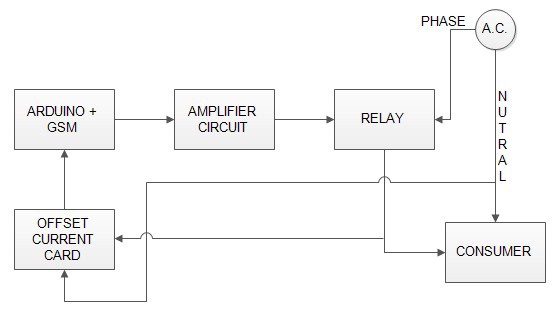
The offset current conditioning card gives the energy consumed by consumer after 10 minutes to Arduino. Arduino sense this value, here this value is less than programmed value means less than 30 Watt. The relay will not activate and power of that consumer remains continue. Here in this result black dots indicates the consumer utilizing energy below given value after every 10 minutes. The graph is plotted Energy Consumption vs. Time. Programmed value is 30 Watt. The consumer starts to consume the electricity. If consumer exceeds 30 watt then relay get activated and power supply of that consumer get cut off.
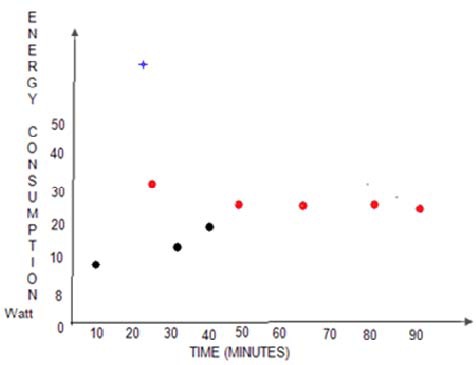
Although government implemented new plants for generation of electricity. But along with generation we have to concentrate on energy management by using today's technology. To manage available electricity some part of villages or cities goes in dark means no single bulb can glow this is. This is nothing but load shedding. From analysis of research paper since from 2005 the Maharashtra’s power sector was fails to provide required electrical energy to the Maharashtra.
[1] Rajesh V. Sakhare, and B. T. Deshmukh, “Wireless Effective Energy Management by Using Zigbee,” International Journal of Engineering Research & Technology (IJERT), vol. 1, no. 7, September 2012.
[2] Rahul N. Dhole, Vishal S. Undre, and Satish R. Pawale, “Arduino Based Noise Detection and Image Capturing by Using Matlab,” National Conference on Advances in Computing ,Networking and security, Dec. 2013, pp. 143-146.
[3] P.Garg, “Energy Scenario and Vision 2020 in India,” Journal of Sustainable Energy & Environment , vol. 3, pp. 7-17, 2012.
[4] Qixun Yang; Tianshu Bi; and Jingtao Wu, “WAMS Implementation in China and the Challenges for Bulk Power System Protection,” IEEE Power Engineering Society General Meetingpp, June 2007, pp. 1-6.
[5] Bhagwan B.Patil, “Maharashtra State Power Supply and Demand Scenario –A Case Study,” International Journal of Advanced System and Social Engineering Research, vol 2, no. 1, pp. 16-21, 2013.